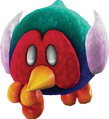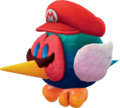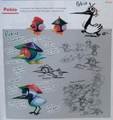Pokio: Difference between revisions
(other mechanics.) |
(trimming boss data to two sentences, and touching up other places. Sentence for power.) |
||
| Line 3: | Line 3: | ||
|first_appearance=''[[Super Mario Odyssey]]'' ([[List of games by date#2017|2017]]) | |first_appearance=''[[Super Mario Odyssey]]'' ([[List of games by date#2017|2017]]) | ||
}}{{quote|Huzzah! It's one of those animals with the stretchable beak! I have so wanted to see one up close!|[[Bonneter biologist]]|''[[Super Mario Odyssey]]''}} | }}{{quote|Huzzah! It's one of those animals with the stretchable beak! I have so wanted to see one up close!|[[Bonneter biologist]]|''[[Super Mario Odyssey]]''}} | ||
'''Pokios''' are pheasant-like enemies found in [[Seaside Kingdom]], [[Bowser's Kingdom]], and [[Darker Side]] in ''[[Super Mario Odyssey]]''. They wander around, but chase [[Mario]] if they see him and stop to poke him with their extending beak. The beaks rebound off any wall. According to the [[Bonneter biologist]], their beaks are normally short due to being in an extremely folded state, but shoot outwards when they are opened. To [[capture]] them, the player must first knock off the samurai helmet that they wear. Once captured, Mario can poke enemies and blocks with his beak, though he also cannot move while poking. | '''Pokios''' are pheasant-like enemies found in [[Seaside Kingdom]], [[Bowser's Kingdom]], and [[Darker Side]] in ''[[Super Mario Odyssey]]''. They wander around, but chase [[Mario]] if they see him and stop to poke him with their extending beak. The beaks rebound off any wall. According to the [[Bonneter biologist]], their beaks are normally short due to being in an extremely folded state, but shoot outwards when they are opened. To [[capture]] them, the player must first knock off the samurai helmet that they wear. Once captured, Mario can poke enemies and blocks with his beak, though he also cannot move while poking. The attack is more effective than the [[Cap Throw]], as it is able to defeat [[Spiny|Spinies]] and other Pokios in one hit. It can also be used to flick incoming [[bomb|cannonball]]s into the opposite direction, which can break destructible blocks. The beak can be held in the extended state, though this does not affect enemies. When Mario quickly spins around, or the controller is flicked, the Pokio will twirl. In the air, this provides a light boost upward. When the beak is extended, this becomes a spinning attack, which grants some movement and ends with the beak retracted. Touching a [[spark pylon]] with the beak captures the pylon. | ||
If Mario pokes at a wall, he can cling onto it and fling himself any desired direction, similarly to to [[Pole (bollard)|Poles]]. | If Mario pokes at a wall, he can cling onto it and fling himself any desired direction, similarly to to [[Pole (bollard)|Poles]]. This is useful for climbing up walls. However, rocky and metallic walls, including [[Moon Rock]]s, repel the attack. (Blocks can be clung to, but metal behind them is still capable of repelling the beak.) If the spin is used while poking a wall, the Pokio will jump about the height of a [[Somersault|Backwards Somersault]]. Some Power Moons are unlocked by poking a Pokio's beak in holes. | ||
Pokios are dropped from [[RoboBrood]] in its earlier boss battle in Bowser's Kingdom. These Pokios are key to the battle against the machine. | |||
The Pokio's name is a play on the words "poke" and {{wp|Pinocchio}}, a character whose nose grows whenever he lies. Their design is based on the Japanese {{wp|green pheasant}}, though the {{wp|red-crowned crane}} was considered.<ref>Roberts, R.; Blenk, J. (2017). ''[[The Art of Super Mario Odyssey]]''. [[Dark Horse Comics]]. p. 273.</ref> The [[Prima Games|Prima]] guide mistakenly classifies them as {{wp|woodpecker}}s. | The Pokio's name is a play on the words "poke" and {{wp|Pinocchio}}, a character whose nose grows whenever he lies. Their design is based on the Japanese {{wp|green pheasant}}, though the {{wp|red-crowned crane}} was considered.<ref>Roberts, R.; Blenk, J. (2017). ''[[The Art of Super Mario Odyssey]]''. [[Dark Horse Comics]]. p. 273.</ref> The [[Prima Games|Prima]] guide mistakenly classifies them as {{wp|woodpecker}}s. | ||
Revision as of 00:19, August 15, 2024
| Pokio | |
|---|---|
Artwork of a Pokio from Super Mario Odyssey. | |
| First appearance | Super Mario Odyssey (2017) |
- “Huzzah! It's one of those animals with the stretchable beak! I have so wanted to see one up close!”
- —Bonneter biologist, Super Mario Odyssey
Pokios are pheasant-like enemies found in Seaside Kingdom, Bowser's Kingdom, and Darker Side in Super Mario Odyssey. They wander around, but chase Mario if they see him and stop to poke him with their extending beak. The beaks rebound off any wall. According to the Bonneter biologist, their beaks are normally short due to being in an extremely folded state, but shoot outwards when they are opened. To capture them, the player must first knock off the samurai helmet that they wear. Once captured, Mario can poke enemies and blocks with his beak, though he also cannot move while poking. The attack is more effective than the Cap Throw, as it is able to defeat Spinies and other Pokios in one hit. It can also be used to flick incoming cannonballs into the opposite direction, which can break destructible blocks. The beak can be held in the extended state, though this does not affect enemies. When Mario quickly spins around, or the controller is flicked, the Pokio will twirl. In the air, this provides a light boost upward. When the beak is extended, this becomes a spinning attack, which grants some movement and ends with the beak retracted. Touching a spark pylon with the beak captures the pylon.
If Mario pokes at a wall, he can cling onto it and fling himself any desired direction, similarly to to Poles. This is useful for climbing up walls. However, rocky and metallic walls, including Moon Rocks, repel the attack. (Blocks can be clung to, but metal behind them is still capable of repelling the beak.) If the spin is used while poking a wall, the Pokio will jump about the height of a Backwards Somersault. Some Power Moons are unlocked by poking a Pokio's beak in holes.
Pokios are dropped from RoboBrood in its earlier boss battle in Bowser's Kingdom. These Pokios are key to the battle against the machine.
The Pokio's name is a play on the words "poke" and Pinocchio, a character whose nose grows whenever he lies. Their design is based on the Japanese green pheasant, though the red-crowned crane was considered.[1] The Prima guide mistakenly classifies them as woodpeckers.
Gallery
Artwork of a captured Pokio
Names in other languages
| Language | Name | Meaning | Notes |
|---|---|---|---|
| Japanese | ツックン[?] Tsukkun |
Contration of「突く」(tsuku, "to stab") and the honorific「~くん」(-kun) | |
| Chinese (simplified) | 啄啄儿[?] Zhuó zhuó er |
From a partial repetition of「啄木鸟」(zhuómùniǎo, "woodpecker") | |
| Chinese (traditional) | 拮拮[?] Jié jié |
From the Japanese name | |
| Dutch | Pokio[?] | - | |
| French | Pikonio[?] | From piquer ("to prick") and rearrangement of "Pinocchio" | |
| German | Piekmatz[?] | From pieken ("to sting") and piepmatz ("birdie") | |
| Italian | Picchiolo[?] | Diminutive form of picchio ("woodpecker") | |
| Korean | 찌르군[?] Jjireugun |
From "찌르다" (jjireuda, "to poke") and "~군" (-gun, an honorific for "young boy"), similar to「~くん」(-kun) in Japanese; shared with Jabit | |
| Russian | Тыклик[?] Tyklik |
Diminutive of тыкать (tykat, "to poke") | |
| Spanish | Picarito[?] | From pico ("beak") and pajarito ("birdie") |
References
- ^ Roberts, R.; Blenk, J. (2017). The Art of Super Mario Odyssey. Dark Horse Comics. p. 273.



